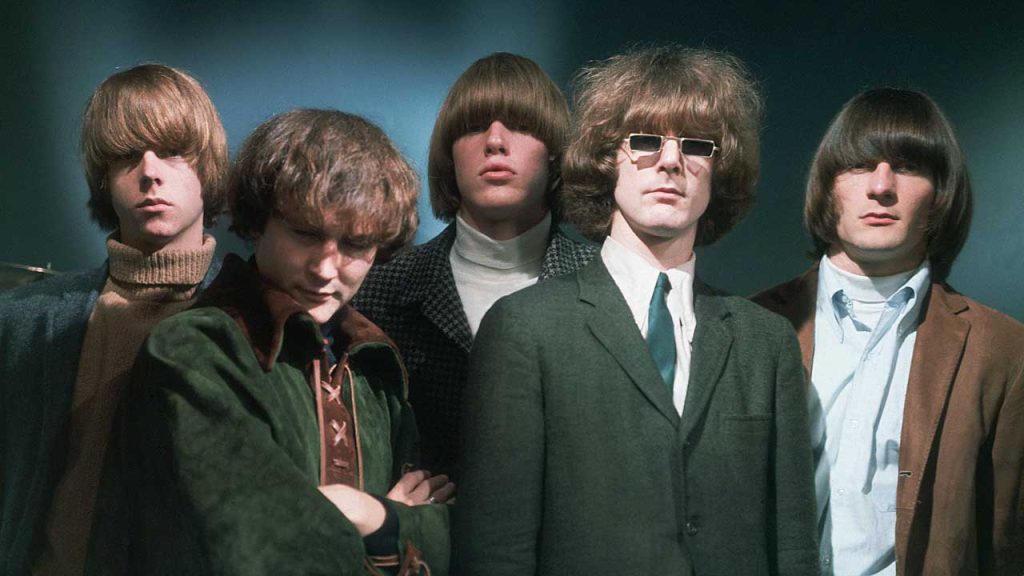“Eight Miles High” by The Byrds is a groundbreaking track that represents one of the earliest and most influential forays into psychedelic rock. Released in March 1966 as a single and later included on the album Fifth Dimension, the song marked a significant departure from the folk-rock sound that had initially defined The Byrds. With its complex structure, innovative instrumentation, and abstract lyrics, “Eight Miles High” has been hailed as a milestone in the evolution of rock music, laying the groundwork for the burgeoning psychedelic movement that would dominate the latter half of the 1960s.

The genesis of “Eight Miles High” reflects the band’s growing interest in pushing the boundaries of rock music. Written primarily by Gene Clark with contributions from Roger McGuinn and David Crosby, the song was inspired by a combination of influences, including the free-form jazz of John Coltrane, the Indian classical music of Ravi Shankar, and the band’s own experiences of touring and exposure to different cultures and ideas. The title itself, “Eight Miles High,” alludes to the altitude of an airplane, but the song has often been interpreted as a metaphor for the altered states of consciousness associated with drug use, a reading that contributed to its reputation as a pioneering psychedelic track.
Musically, “Eight Miles High” is a bold departure from the jangly, folk-influenced sound of earlier Byrds hits like “Mr. Tambourine Man” and “Turn! Turn! Turn!” The song features a complex, dissonant melody that is driven by McGuinn‘s innovative 12-string Rickenbacker guitar work. His playing on this track is heavily influenced by John Coltrane‘s modal jazz, particularly the saxophonist’s use of rapid, cascading runs and improvisational techniques. McGuinn translated these ideas into a rock context, creating a guitar sound that was both hypnotic and otherworldly, perfectly capturing the song’s themes of transcendence and exploration.
The rhythm section, anchored by Chris Hillman on bass and Michael Clarke on drums, provides a propulsive, almost trance-like backdrop that complements the ethereal quality of the guitar. David Crosby‘s rhythm guitar work adds additional layers of texture, while Gene Clark‘s vocals, delivered with a sense of detachment and mystery, enhance the song’s enigmatic atmosphere.
Lyrically, “Eight Miles High” is abstract and impressionistic, reflecting the influence of the Beat poets and the band’s desire to move beyond conventional pop song structures. The lyrics evoke a sense of alienation and dislocation, with lines like “Rain gray town, known for its sound / In places, small faces unbound” suggesting a disorienting experience, perhaps of being far from home or immersed in a new and unfamiliar environment. While the song was partly inspired by the band’s turbulent experiences on their 1965 tour of England, its lyrics have a universal quality that invites a variety of interpretations, adding to its enduring appeal.
Upon its release, “Eight Miles High” faced some controversy. Many radio stations in the United States refused to play the song, believing that its lyrics were a thinly veiled reference to drug use. This perception, coupled with its avant-garde sound, limited its commercial success compared to earlier Byrds singles. Nevertheless, the song reached number 14 on the Billboard Hot 100 and was highly influential in shaping the direction of psychedelic rock and beyond.
“Eight Miles High” was a bold statement from a band that was unafraid to challenge the conventions of popular music. It marked a turning point in The Byrds‘ career, signaling their shift away from the folk-rock genre and towards more experimental sounds. The song’s innovative approach to composition and production helped to expand the possibilities of what rock music could be, influencing countless artists and bands in the years that followed.
Over the decades, “Eight Miles High” has been recognized not just as a milestone in The Byrds‘ discography, but as a landmark in the history of rock music. Its blend of jazz, rock, and Eastern musical influences was revolutionary at the time and has since been credited with helping to pave the way for the psychedelic music explosion that would soon take hold. The song remains a touchstone for musicians and fans alike, celebrated for its daring creativity and its contribution to the evolution of modern music.
In the broader context of The Byrds‘ legacy, “Eight Miles High” stands as one of their most enduring and influential works. It captures a moment of artistic growth and experimentation, reflecting the band’s willingness to take risks and explore new musical territories. For listeners, it offers a journey into the unknown, a sonic exploration of the boundaries of consciousness and sound that remains as compelling today as it was when it was first released.
🎵 Let’s sing along with the lyrics! 🎤
Eight miles high, and when you touch down
You’ll find that it’s stranger than known
Signs in the street, that say where you’re going
Are somewhere just being their own
Nowhere is there warmth to be found
Among those afraid of losing their ground
Rain gray town, known for its sound
In places, small faces unbound
Round the squares, huddled in storms
Some laughing, some just shapeless forms
Sidewalk scenes, and black limousines
Some living, some standing alone